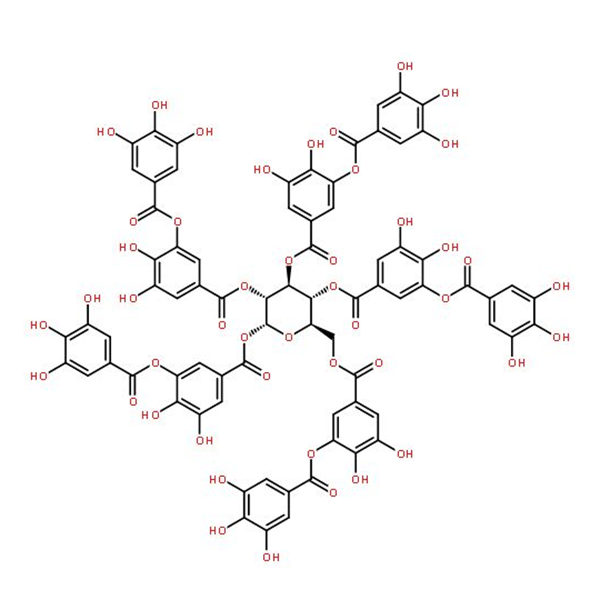
PRODUCTS CENTER
——
Tannic acid
Product DetailsSpecification DataApplication
Other Names: Tannins, Galobutyric Acid, Digallic Acid, Galotinin, Tannins, Oak Bark Tannins,
Chemical Name: 1,2,3,4,6-pento-O-{3,4-dihydroxy-5-[(3,4,5-trihydroxybenzoyl)oxy]benzoyl}-D-glucopyranosyl
Molecular Formula: C₇₆H₅₂O₄₆, 1701.19g/mol
CAS:1401-55-4
| Specifications | Industrial grade |
| Enforce the standard | LY/T1300-2005 |
| Content | ≥81% |
| Loss on drying | ≤9% |
| Water insoluble | ≤0.6% |
| Scale of production | 300T/Y |
| Color | ≤2.0 |
| package | kraft paper bag, 25 kg/bag |
Tannic acid, a naturally occurring polyphenol compound, is widely utilized across various industries due to its exceptional chemical properties. Tannic acid exhibits strong antioxidant, antimicrobial, and astringent characteristics. These attributes make it an invaluable substance in industries such as leather manufacturing, printing and dyeing, paper production, and chemical processing.
Leather Industry
One of the most well-known applications of tannic acid is in the leather industry, particularly in the tanning process. Leather tanning is a critical step in the production of durable and flexible leather goods, and tannic acid plays a key role in this process. When used as a tanning agent, tannic acid forms complexes with collagen proteins found in animal hides, stabilizing the structure of the leather. This treatment enhances the leather’s resistance to decomposition, improving its longevity and flexibility.
Printing and Dyeing Industry
Tannic acid also has significant applications in the printing and dyeing industries. In the dyeing process, tannic acid serves as a mordant, a substance that helps to fix dyes to fibers, ensuring that the color adheres well and remains stable over time.
In textiles, tannic acid is commonly used to treat natural fibers such as cotton, wool, and silk. When combined with natural dyes, tannic acid helps create rich, vibrant colors while enhancing the fabric’s resistance to fading and washing. The use of tannic acid as a mordant is a traditional method in the production of natural dyes, providing an eco-friendly alternative to synthetic mordants that may contain toxic chemicals.
Moreover, tannic acid’s role as a mordant extends beyond its application in textiles to include paper and wood products.
Paper Industry
In the paper industry, tannic acid serves multiple functions, from acting as an additive to enhancing paper strength and durability to aiding in the decolorization process. One of its primary uses is as an additive in the production of high-quality paper products. Tannic acid is incorporated into paper pulp to improve the final product’s mechanical strength, such as tensile and tear strength. By crosslinking with the cellulose fibers in the pulp, tannic acid reinforces the paper, making it more resilient to tearing, folding, and other forms of damage.
Chemical Industry
Tannic acid’s applications extend beyond the textiles, leather, and paper industries into the field of chemical processing, where it is used primarily as a water treatment agent. In this context, tannic acid plays a vital role in improving water quality, particularly in wastewater treatment. One of its key functions is the precipitation of heavy metals from contaminated water, a process that helps reduce the concentration of harmful substances in industrial effluents.
The ability of tannic acid to bind with heavy metals, such as lead, copper, and cadmium, makes it an effective agent for removing these toxic substances from wastewater. By forming insoluble complexes with the metals, tannic acid aids in their removal from the water, preventing pollution and ensuring compliance with environmental regulations. This makes tannic acid a valuable component in industries such as mining, manufacturing, and textiles, where wastewater treatment is an essential part of the production process.
In addition to its role in wastewater treatment, tannic acid is used in the formulation of various chemical products. It can act as a stabilizer or preservative in certain formulations, prolonging the shelf life of chemicals and preventing oxidation or degradation. Its ability to act as a reducing agent makes it useful in the synthesis of certain chemical compounds, and its antimicrobial properties also allow it to serve as a preservative in certain formulations.
Keyword: Tannic acid
Prev: Pyrogallol
Next: Nothing!
Product Inquiry
Related Products
Products
-

Gallic acid
Chemical name : 3,4,5-trihydroxybenzoic acid. Molecular formula:C₇H₆O₅ CAS: 149-91-7 It can be widely found in the nature, such as Rheum Palmatum, Swamp Mahogany, dogwood, etc. Gallic acid is widely applied in multiple fields such as food, biology, pharmaceutical, chemical industry, semiconductor, etc.
-

Methyl gallate
Chemical name : 3,4,5-trihydroxybenzoate. CAS:99-24-1; Chemical formula:C₈H₈O₅. It is widely applied in multiple fields such as food, biology, pharmaceutical, chemical industry, semiconductor, etc.
-

Propyl gallate
Chemical name: 3,4,5-trihydroxybenzoate. CAS:121-79-9; Molecular formula : C₁₀H₁₂O₅. It is used as an antioxidant additive in industries like food pharmaceutical, cosmetic, hair care product, feed and semiconductor; and as a stabilizer in manufacturing of green fiber and a rubber antioxidant.
-

Pyrogallol
Pyrogallol is also called pyrogallic acid. Chemical name: 1,2,3-trihydroxy benzene. CAS:87-66-1 Molecular formula :C₆H₆O₃. It is obtained by decarboxylic reaction of gallic acid.
-

Tannic acid
Tannic acid also called tannin is an organic compound. CAS:1401-55-4 Chemical formula: C₇₆H₅₂O₄₆. Tannic acid can be used for making gallic acid.

